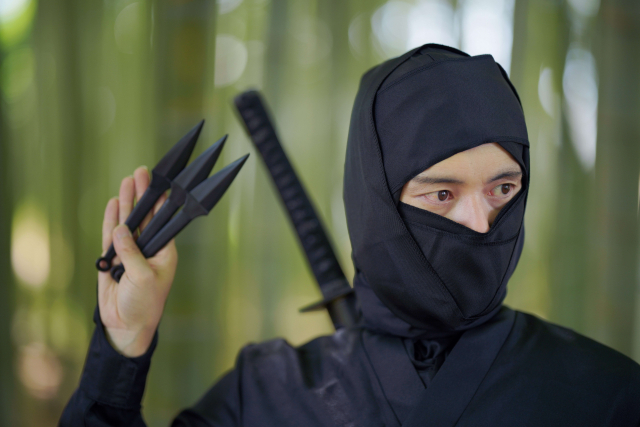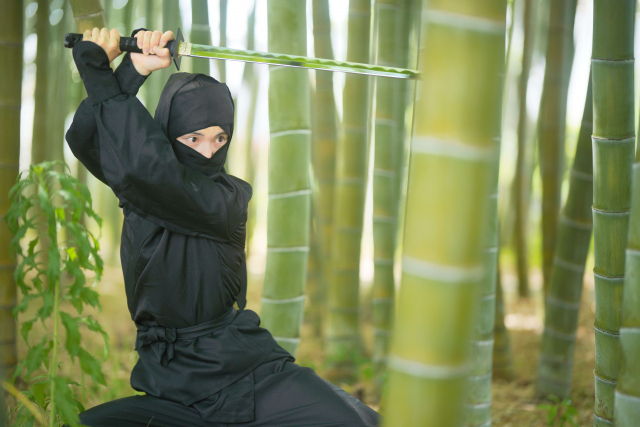For those who have never been to Japan, some may have an image of “Japan = Ninja.
However, in some cases, they may not have a good understanding of what kind of person a ninja actually is.
In addition, foreigners who already live in Japan or have visited Japan many times know that ninja are not found in Japanese cities, but is there really not a single ninja in the modern world?

Click here to learn Japanese language with the best one-on-one Japanese tutoring lessons in online.
In this article, I would like to explain the origins and characteristics of the ninja and whether they exist in modern Japan.
Contents
What is a ninja?
Let us first explain what kind of person a “ninja (ninjya)” is.
A ninja is a person who served lords and feudal lords from the 1400s to the Edo period, and was in charge of “espionage, intrigue, and assassination.
It is said that the official term “ninja” was first coined in the 1950s.
Until then, they were called “shinobi.
They sometimes disguised themselves to convey information about the enemy camp to their lord, and were also in charge of sabotage and other operations.
For this reason, it is said that quick movements and fighting ability were essential.
Their special movements are known as “ninjutsu,” which include the art of water fugu, such as hiding under water, and the art of fire fugu, which involves the use of fire weapons or fire to hide oneself.
The weapons used by the ninja are not “Japanese swords” like those held by the samurai.
Shuriken, a weapon shaped like a windmill.
The kunai, used to break locks and climb walls.
The makibishi, used to throw pursuers.
Kusarigama, a weapon used to throw chains at a target to block its movement and then kill it with a sickle
The torinoko, a Japanese paper wrapped in gunpowder and attached to a fire rope to be used like a hand grenade
The “ninja sword,” a sword used by the ninja.
As you can see, the ninja used a wide variety of weapons and tools to carry out their roles.

Types of Ninja in Japan
There are different types of ninja depending on the region.
Here are some of the most famous types of ninja.
Iga Ninja
The Iga Ninja were based around Iga and Nabari cities in the northwestern part of Mie Prefecture in modern times.
Among the many types of ninja, the Iga Ninja were characterized as being good at ninjutsu and combat.
They were not highly loyal, and in many cases worked under a contract with their employers that included money.
Because of the easy access to gunpowder in the region, they were particularly skilled in the art of fire-escape.
One of the main reasons why the Iga Ninja were so valued in this region was that there were many mountainous areas.
The quick-moving Iga ninja played an important role in various battles.
Koga Ninja
Along with the Iga Ninja, the Koga Ninja are the most famous ninja in Japan.
The Koga Ninja were active mainly in Koka City, Shiga Prefecture, in modern times.
Their major characteristic is that they were an independent force.
The general image of the ninja is that they always served some lord, but the Koga Ninja lived as an autonomous organization while maintaining order.
The Koga Ninja lived as an autonomous organization, maintaining order and cooperating only when requested to do so.
Koga had easy access to medicinal herbs because of its location.
Therefore, it is said that they had a high level of knowledge about medicines and collected information as medicine sellers.
The existence of the Koga ninja became known throughout Japan as a result of their great success in the Choukyou-Entoku Rebellion of 1487, a battle between the Rokkaku family and the Shogunate.

Other Ninja
In Japan, the aforementioned Iga and Kouga ninja are well known, but there were various other ninja active in various parts of Japan.
- The Zatoshu, who served under Mori Motonaga
- The “Eavesdropping Monkey” served under Kenshin Uesugi.
- The “Oniwaban” served the Tokugawa Shogunate.
- Of these, the “Oniwaban” is particularly famous in Japan.
The number of people who know about the Oniwaban has increased rapidly since the popular manga (anime) “Rurouni Kenshin,” in which several characters appear as Oniwabans.
In particular, “Shinomori Souji,” the head of the Oniwaban, has become one of the most popular characters in the work.
Although he is not a person who actually existed, many Japanese people will associate him with the Oniwaban.
Ninja still exist in Japan.
As explained at the beginning of this article, “from the 1400s to the Edo period,” real ninja who made their living by actual warfare no longer exist.
However, in reality, the Koga Ninja still exist in Japan.
Mr. Jinichi Kawakami, who is the 21st generation, is that person.
Mr. Kawakami is a ninja who has passed down legitimate ninja techniques, and even today he is spreading the existence of the ninja to the world by giving lectures and posting videos on YouTube and other media.
In addition, there are a number of facilities in Japan where visitors can learn about and experience the ninja.
- Togakushi Chibikko Ninja Village
- Koga no Sato Ninjutsu Mura
- Koga Ninjutsu Yashiki (Koga-style Ninja House)
- Iga Ninja Museum
- Nikko Edomura
- Ise Ninja Kingdom
- Oshino Shinobino-no-Sato
At these facilities, you can see tools actually used by the ninja and have a ninja experience.
If you are a foreigner who wants to know more about the ninja, why not visit one of these facilities?

Conclusion
In this issue, we have explained about the origin and characteristics of the ninja and whether they exist in modern Japan.
The ninja is a Japanese culture that is widely known even among foreigners.
In fact, they almost do not exist today, but they will continue to be passed down as part of history.
It is interesting to visit facilities such as ninja villages, and why not check out ninja movies and manga?










